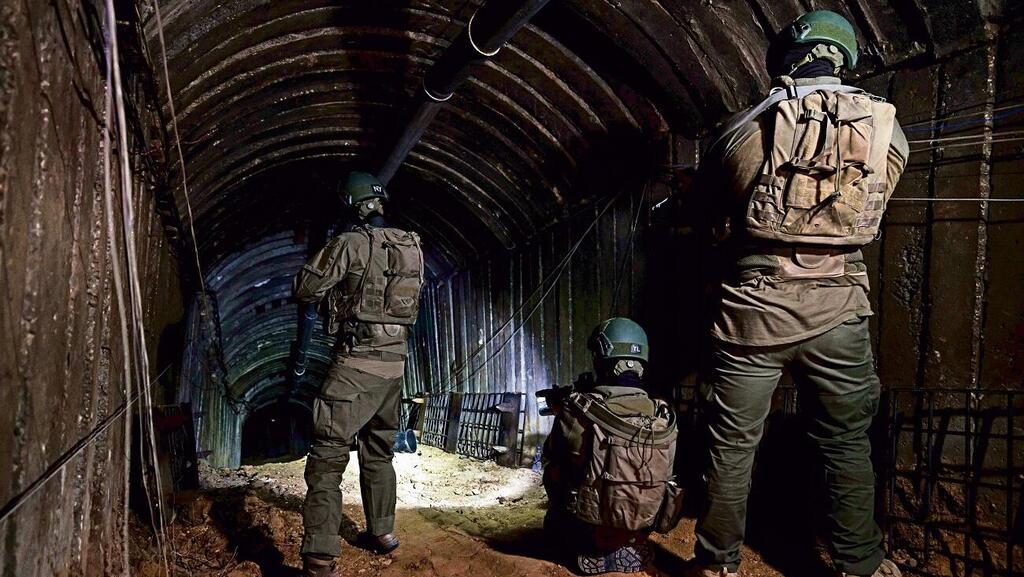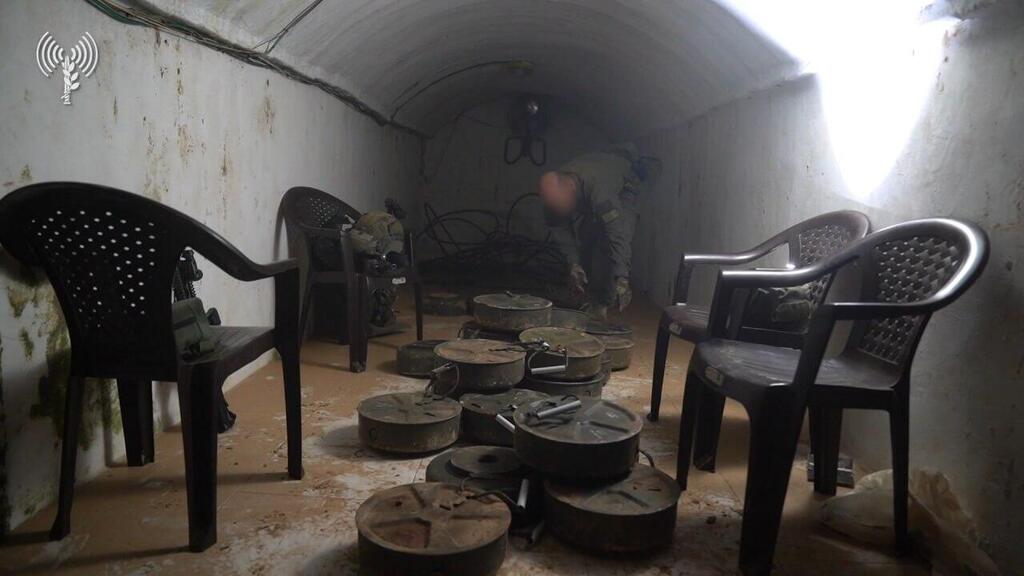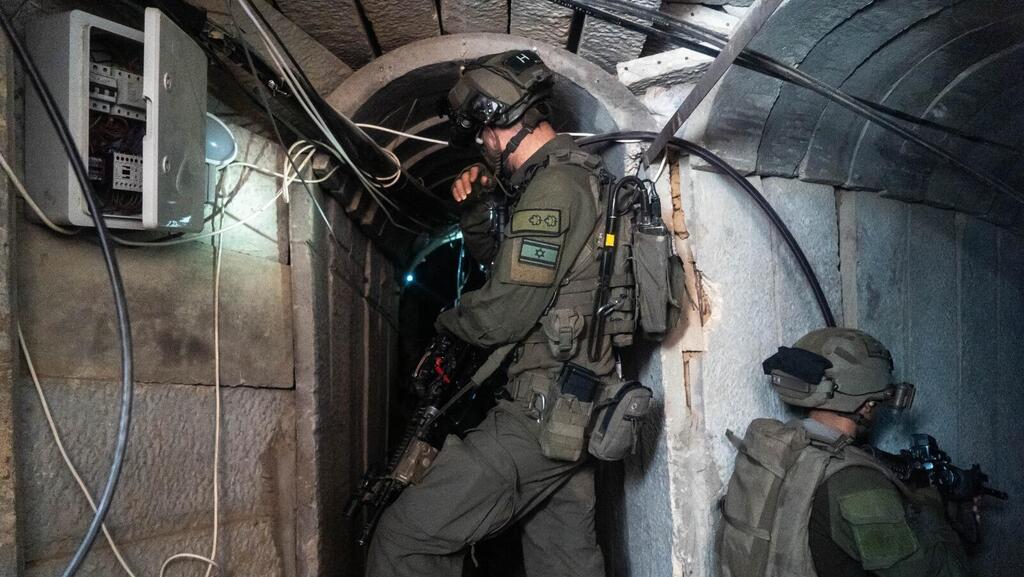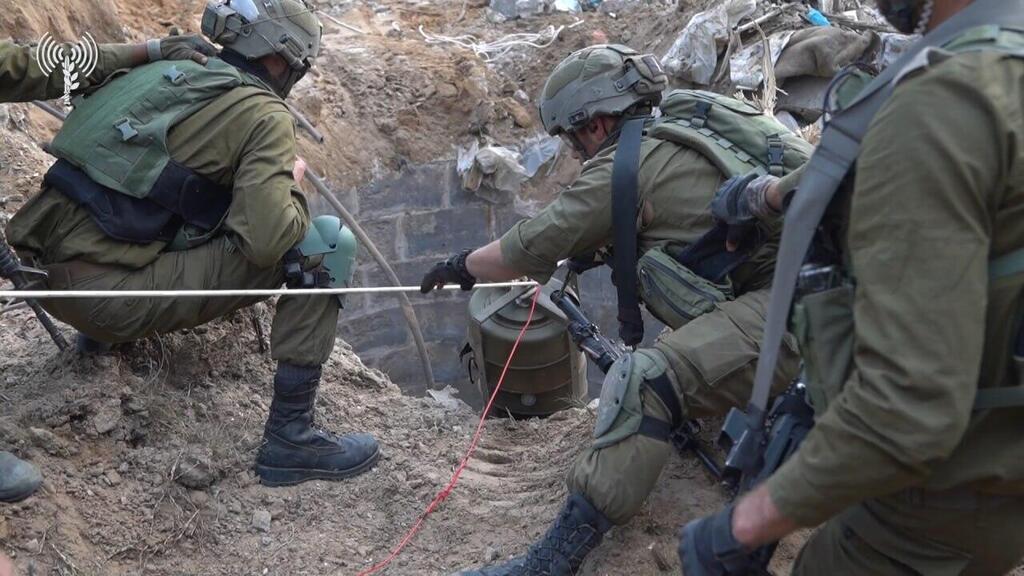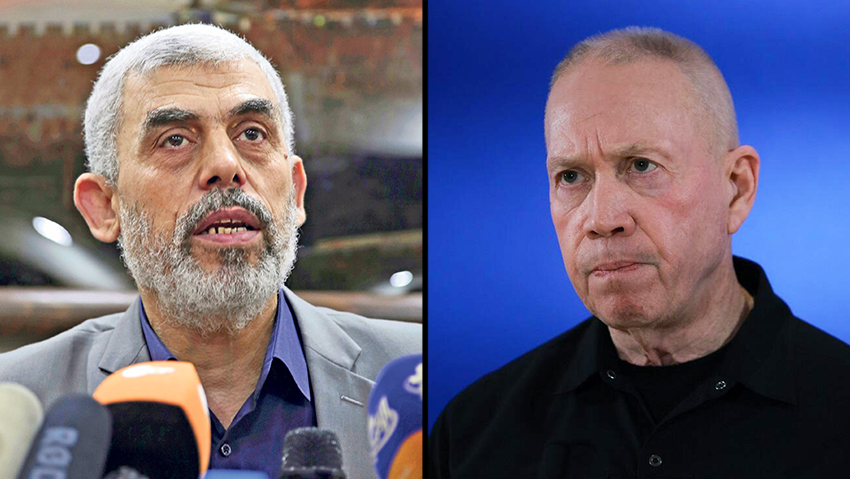Until the seizure of materials in Hamas facilities in Gaza City, we were unaware of the true extent, structure, and purpose of the underground systems that the organization had dug throughout the Gaza Strip. The Intelligence Corps also did not recognize their vast scope and sophisticated structure, primarily in Khan Younis. It was only when intelligence personnel began extracting information from seized documents in Gaza that it became clear that Yahya Sinwar, Mohammed Deif, and other leaders of Hamas had prepared for the possibility of an Israeli ground incursion into the Strip following the attack into Israeli territory.
Read more:
Indeed, when the IDF began incursions into Gaza City, Sinwar and his comrades fled from the subterranean Hamas command centers of northern Gaza to the compounds in Khan Younis where they likely remain with the hostages. Now, IDF special forces are pursuing the group in the labyrinth of branching tunnels while the Hamas leadership flees and remains in constant motion with their human shields.
The IDF believes that subterranean warfare may directly lead to the release of captives, although not all at once, and primarily it generates pressure on Sinwar to hasten a ceasefire or at least a cessation of hostilities. John Spencer, head of the Urban Warfare Division at the U.S. Military Academy at West Point, argues that Hamas' goal in constructing the tunnel network was initially to buy time until Israel was compelled to cease the fighting, allowing Hamas to survive.
Therefore, Hamas also built its resistance facilities above and mainly beneath the ground, within and beneath residential buildings and community structures that the Gazan population relies on daily and finds refuge in during wartime. This is why the main tunnel facilities are located beneath hospitals, schools, mosques, clinics and UN facilities.
Hamas learned from the IDF operational pattern, which operates within the boundaries of international law, allowing combat and targeting of civilian facilities only if they have a clear military value or use. Hamas aimed to cause casualties among "non-combatants" so that the Americans and the UN would force Israel to cease. In the IDF, it was immediately understood that this was Hamas' goal. Therefore, Defense Minister Yoav Gallant and IDF Chief of Staff Herzi Halevi emphasized in their statements that the fighting would be prolonged, lasting at least a year. This was a message to Sinwar that his strategy this time would not succeed.
At the outset of the war, the IDF specifically avoided engaging in direct combat within the tunnels. Special units, including the Yahalom unit of the Engineering Corps, indeed trained for tunnel entry, but it was clear that it was a dangerous matter and they were at risk. The logic then was that fighting inside would not only raise the cost in blood but also be senseless since most of Hamas' resistance facilities could be demolished first in the north of the Strip and then in the south, fighting above ground by blowing up and sealing the openings leading into the tunnels. This way, terrorists hiding inside the tunnels would be trapped until their death.
The directive to seal tunnel openings or blow them up was given regarding "defensive tunnels," as Hamas calls them. These are the shallow tunnels used by the Hamas terrorists and are intended for hidden movement under the ground between battlefronts. These are narrow and low tunnels not designed for staying for more than a few hours. The destruction of the openings was and is done in an orderly process: after discovery, a robot with a camera is lowered into it for investigation. If there is doubt, a larger and more sophisticated robot or a dog is sent, and then a decision is made whether to neutralize the opening or keep it for further investigation of the tunnel. The problem was that Hamas, in most cases, rigged the surroundings of the openings with explosives, causing considerable harm to soldiers.
Even when the offensive began in the Khan Younis, the commander of the 98th Brigade ordered troops under his command to expose the tunnels but not to linger on them, instead blowing them up and moving forward. But then the true picture of the tunnel system in the Gaza Strip, especially in Khan Younis, became clear.
Information gleaned from interrogations of captives, Hamas terrorists, and seized documents supplemented the details and refined the information. Until that exposure, the IDF estimated that about 500 kilometers of tunnels of all types were dug throughout the strip, leading to several hundred openings. Today, the IDF knows that there are at least 750 kilometers of tunnels of all types in the strip, perhaps even more than 1,000 kilometers, and the number of openings exceeds 1,500.
Moreover, the terrorists inside the tunnels are the loyal and secretive ones who can provide information that those who surrendered above ground mostly do not possess. They are found with senior Hamas officials who move through the tunnels according to the IDF's pace of progress pace. These facts and the structure of the subterranean systems led the IDF to conclude that if they wanted to neutralize Hamas' leadership, moving stealthily from hideout to hideout within the tunnel network in Khan Younis, there was a need to fight within it and reach the head of the snake where it resides.
The decision to conduct combat within the tunnels was not immediate. But in a discussion held during the hostage release, the head of the Intelligence corps told participants that there would be no choice but to enter the tunnels to pursue the enemy, not just to fight them sporadically in confrontations above ground. Not all participants in the discussion agreed with him. In the end, the IDF developed methods of detection and combat within the tunnels, which American expert Spencer claims are the first of their kind in the world.
In an article published in the professional journal of the War Research Institute at West Point, he writes: "The pace of the IDF's advancement above and below ground is historically fast. The Gaza theater cannot be compared to any other in modern military history in terms of the size of the challenges it poses. ... Hamas' strategy is based on time and tunnels - they hope that Israel will exhaust its time resources by focusing on the tunnels."
To deeply understand the challenge of fighting in tunnels, one must first understand the types of tunnels Hamas dug. The first type is "infiltration tunnels," dug under the border fence with Israel to penetrate Israeli territory. Most of these tunnels were exposed during Operation Protective Edge in 2014 and destroyed at various times since. After the construction of the above-ground and underground barrier along the Gaza border, Hamas ceased digging infiltration tunnels and shifted to "approach tunnels," intended to approach the border barrier and then breach the tunnels to infiltrate Israeli territory. On October 7, Hamas ultimately did not use those approach tunnels, deciding instead to attempt the breach from above ground using tactics and neutralizing the IDF's intelligence and technological system along the border.
The second type is the "network tunnels," designed for battalion-level combat in a relatively large area, such as Gaza City, Jabaliya, or Shijaiyah. These tunnels are over two meters high and wide, allowing movement at high speeds with large forces, even using motorcycles and small vehicles. The IDF calls them "artery tunnels," with many branches leading off to tactical combat tunnels. Observations and cameras are connected to command and control rooms located underground, allowing monitoring of IDF movements and guiding anti-tank cells and explosives-laden terrorists toward IDF vehicles.
The third type is what the IDF calls "strategic tunnels," designed for shelter and command and control of Hamas' military and political leadership, as well as for holding captives and facilitating movement between different combat zones. In these strategic tunnels, Yahya Sinwar and the leadership move. Outside the openings of these tunnels, small vehicles are found, likely for the use of Sinwar, who struggles with walking, or other leaders who cannot travel long distances, above or below ground.
The tunnel network in Khan Younis is the largest of all. Not only because it's the home base of Yahya Sinwar and Mohammed Deif, and their families, but also because the terrain in southern Gaza, geologically, is more conducive to digging, with deeper underground depths than in northern Gaza. Therefore, the tunnels in the Khan Younis area are deeper and wider. They extend tens of meters below ground, making them difficult to bomb from the air with bunker-busting bombs.
The openings leading to the strategic tunnels in Khan Younis and other areas are equipped with elevators for convenient entry and exit. This was also the case with tunnels beneath Shifa Hospital, serving as a command and control center for Hamas' central leadership, and beneath Nasr Hospital in western Khan Younis, in the refugee camp, where fighting is still taking place.
Where does this immense expertise come from? A bit of history: During the first intifada, Gazans - mainly private citizens - began digging tunnels for smuggling goods between Egypt and Gaza, known today as the "Philadelphi Corridor." Hamas, now a terrorist organization, quickly recognized the potential and began digging its tunnels at that time for smuggling weapons and explosives. Over the years, especially after the disengagement, smuggling tunnels developed into a profitable industry. At its peak, there were 1,200 functioning tunnels beneath the Philadelphi Corridor, through which vehicles transported food, fuel, cigarettes and even Iranian missiles.
During those years, "the tunnel enterprise" was the most profitable business in the strip. That was until Abdel Fattah el-Sisi seized power in Egypt. He instructed his army to act decisively against the Philadelphi Corridor tunnels, not out of love for Israel but out of hatred for Hamas. The directive was mostly carried out. Still, a few hundred civilian escape tunnels remained under the corridor, but the number of workers in them decreased dramatically.
As a result, Hamas shifted to domestically producing anti-tank guided missiles with Iranian guidance within the Strip. Tens of thousands of skilled workers and engineers who had been expelled from the escape tunnel industry transitioned to digging Hamas' tunnel networks inside Gaza. There's an unverified intelligence claim that Hamas received engineering know-how for building a multi-level, multi-purpose underground network from North Korea, where there's a tunnel and bunker system estimated to span 5,000 kilometers.
The IDF developed technologies and working methods enabling them to combat tunnels inaccessible to conventional combat maneuvers. The tunnels were narrow, making it impossible to maneuver in them or take cover when under fire. Hamas, apparently, especially in Khan Younis, underestimated that the IDF would engage them within the tunnels.
Therefore, they mainly captured the tunnel leaders. Additionally, they planted explosives inside the tunnels in areas they fled from, and constructed "blast doors" made of steel to minimize damage caused by bombs dropped from the air. Bombs penetrating bunkers or exploding charges inside tunnels cause extensive destruction because the tunnel is airtight, and the blast wave can propagate over long distances. Blast doors, equipped with shooting slits, were designed to prevent this. They were also intended to delay IDF soldiers if they were to enter the tunnels, but IDF special units managed to develop methods to detect the enemy from a distance and advance inside the tunnels without being detected.
It's impossible and undesirable to detail these methods, but the American expert mentioned the use of "mole units," likely referring to tunneling units, and the use of various robots, including mini-drones and other types of robots equipped with cameras that can approach silently. Regarding dogs, it's worth noting that deploying them above and below ground in Khan Younis comes at a heavy cost. Out of dozens of dogs the IDF operated in Khan Younis, only one remains. The rest were killed or injured. It's important to clarify that the canine unit did not collapse: not all its dogs were trained to operate inside tunnels, and even of those that were, not all were sent to Khan Younis. And the unit quickly recovered. Currently, the IDF is purchasing tunnel-suited dog breeds in bulk from abroad and training them.
In one instance in Khan Younis, IDF elite fighters managed to surprise militants who manned one of the strategic underground anti-tank guided missiles. The unit awakened the terrorists from their sleep, subdued them, and disconnected the masks connected to cameras installed above ground to monitor IDF movements. In another case, IDF soldiers reached the blast door and successfully opened it. Behind it were three terrorists who surrendered and now provide invaluable information about Hamas leadership and hostages.
Subterranean warfare is the main innovation in how the IDF fights in the strip, directly or indirectly assisting the effort to free hostages. Generally, the claim that Hamas murders captives when IDF forces are approaching them is not true: intelligence gathered so far indicates there was only one likely case - when the terrorists murdered hostage Sahar Baruch, and that occurred only after the IDF attempted to rescue him. He likely was murdered in retaliation for the terrorists killed in the raid. Yes, there were cases where Hamas members holding hostages harmed them - either out of anger or revenge. But from a strategic standpoint, they are the main card to ensure the terrorists' survival.
According to intelligence confirmed through findings collected in the field during combat, the hostages were held in above-ground homes or the deep strategic tunnels: the "strategic tunnels" and, in some cases, the "network tunnels," which included rooms, halls and even prison cells, as well as utilities, electricity and ventilation. These allow for prolonged stays, even if they are not always comfortable. In these deep tunnels, the hostages - whom Hamas sees as a strategic asset - are relatively protected from Air Force bombings. The IDF did not touch these tunnels and certainly did not detonate them until every such tunnel was thoroughly researched and scanned over its entire length several times, including soldier patrols.
In the IDF and security establishment, it is clear that the fighting in Khan Younis has not yet ended, and Defense Minister Gallant told his American counterpart Lloyd Austin that the fighting in the city, with varying intensity, will continue even after they move to the stage of raids into the territory without being constantly present. This need to be in Khan Younis is also due to the need to destroy the tunnels.
Can "all the tunnels" be destroyed? If we're talking about the hundreds of kilometers of shallow tunnels - should the IDF wanted to explore and destroy them entirely, the careful work would take several years and would not be enough with all the explosives in the Western world. Therefore, the focus is on exploring in-depth and systematically destroying "network" tunnels and other strategic tunnels after physical verification that there are no captives in them. This also explains the bizarre fact - that 80% of the tunnels are still functioning - published this week in the Wall Street Journal.
The methods for destroying the tunnels are varied and include seawater flushing. Some argue that the project is still not effective enough, and Hamas is digging the tunnels deep enough to reach moisture due to groundwater seepage. The IDF also avoids flushing seawater into places where the tunnel is deep, as pumping seawater into it could salinate and contaminate the sweet groundwater of the coastal aquifer, which feeds Gaza's water wells. In any case, the IDF continues to flush water into tunnels even in Khan Younis, far from the sea. Another safer but very labor-intensive and slow method is laying explosive charges along the tunnel's length, and another method is bombing from the air, which is also problematic because it involves specific locations impacting bystanders.
Defense Minister Yoav Gallant addressed the issue of tunnel destruction and hinted that it would continue for a long time. "The work of neutralizing terrorist infrastructures and tunnels," he said this week, "is not endless. It is complex, it has costs, and we are progressing in this matter." Indeed, the IDF already sees results attributed to the fighting in the tunnels of Khan Younis. In recent days, intermediaries have learned that Sinwar has softened his stance.
This fact prompts the IDF to continue to focus more on subterranean warfare in the Khan Younis area, as of this writing, without losses to our forces underground. It can also be said that the achievements of this underground warfare enable Israel and the Cabinet to display more flexibility regarding the duration of the future deal to release captives and, in general, the IDF estimates that such a deal, even if long, will make it difficult for us when and if we renew the fighting in the buffer zone. It may even create conditions for a broader diplomatic arrangement and restore security to the borders, even for northern residents.



